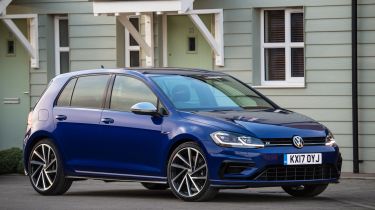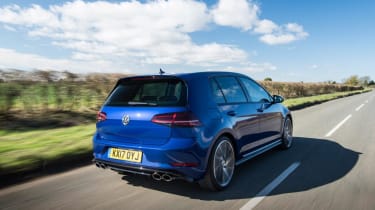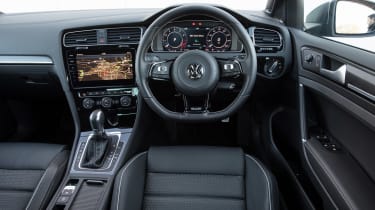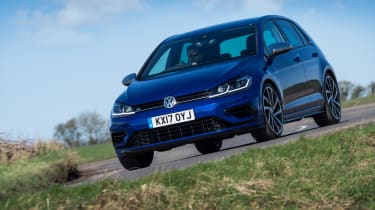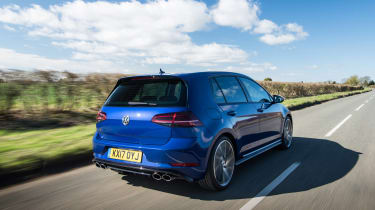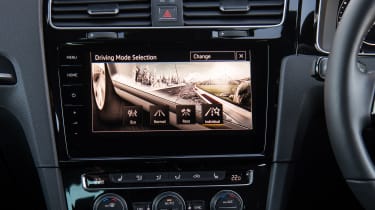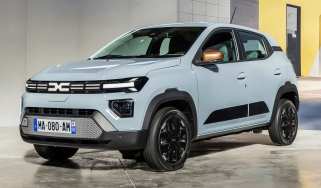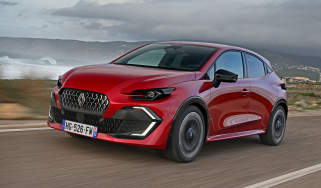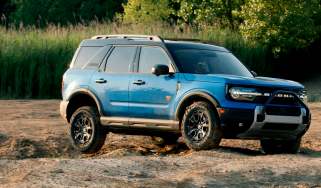Used Volkswagen Golf R (Mk7, 2013-2020) buyer’s guide: supercar pace for a supermini price
A full used buyer’s guide on the Volkswagen Golf R, covering the Golf R Mk7 that was on sale between 2013 and 2020
Verdict
The Mk7 Volkswagen Golf R is pretty much all you could ever want in a car. It’s blisteringly quick, very well made, has lots of kit and is very discreet. Thanks to its 2.0-litre engine, it can also be reasonably frugal, plus you get the security and efficiency of part-time four-wheel drive. That AWD system means the boot is slightly smaller than a regular Golf’s, but if load capacity is a priority there’s the Golf R Estate. Thanks to keen leasing deals new, supply of used Rs is plentiful; most came without any options. Despite this, we can’t think of a good reason not to buy a Golf R.
When a team of engineers from Volkswagen created a hot Golf Mk1 in their own time, the result was the Golf Sport concept, which made its debut at the 1975 Frankfurt Motor Show.
Volkswagen took a lot of convincing that there was a viable market for a hot hatch, but it put the Golf GTI into limited production, and was overwhelmed by the demand.
The GTI became something of an icon as it made its mark as a staple part of the Golf line-up, accounting for up to 10 per cent of sales. As the bar was raised ever higher, so the GTI got increasingly powerful.
Used - available now

2017 SEAT
Ibiza SC
50,238 milesManualPetrol1.2L
Cash £7,250
2016 Audi
S5
48,749 milesAutomaticPetrol3.0L
Cash £16,850
2017 Mazda
CX-5
63,000 milesManualPetrol2.0L
Cash £12,050
2017 Toyota
Auris
38,754 milesAutomaticPetrol1.8L
Cash £8,750Then, the even more performance-orientated Golf R32 was launched, and that was followed by the Golf R, which reached the milestone of breaching the 300bhp barrier for the first time.
History
Whereas the original Golf GTI packed a 110bhp punch, the original four-wheel-drive Mk6 Golf R that arrived in February 2010 was rated at the much higher figure of 265bhp. The Mk7 Golf R featured here was launched in March 2014 with an even more potent and mouth-watering 296bhp.
The newcomer was available with three or five doors, and there was a choice of six-speed manual or DSG automatic gearboxes. Power came from a 2.0-litre four-cylinder turbocharged petrol engine. By July 2015 the R was also offered in a more practical Estate body style, with the same mechanical specification as the hatchback version.
An updated Golf R arrived in April 2016 with LED lights all round, digital dials, a new infotainment system, a 10bhp boost and a number of exterior design tweaks.
Prices
There are plenty of used Volkswagen Golf Rs on the market, many of which are available through our Buy a Car service. Prices start from just over £10,000.
Check the price of a specific Volkswagen Golf R with our free car valuation tool...
Which one should I buy?
Most Golf Rs have five doors and a DSG automatic transmission; if you prefer a sportier look and don’t care too much about rear seat access, a three-door model might better suit your needs.
Both manual and auto boxes are great to use, so which one you go for is just a matter of personal preference. All Golf Rs come with sports suspension, 18-inch alloy wheels and xenon headlights.
A Performance Pack was also introduced in November 2017. Available only with the DSG transmission, it brought 19-inch alloys, stronger brakes and a 166mph top speed (168mph for the estate). There was a sporty rear spoiler for the hatchback, too.
Alternatives to the Volkswagen Golf R Mk7
The Golf GTI and GTD offer many of the R’s features and benefits, but in packages that are cheaper to buy and run.
After the urgency of the Golf R, these might seem rather anaemic, though, which is why Audi’s 362bhp (later to be 395bhp) RS 3 might hold more appeal for those after a performance-focused experience. Yet while the RS 3 is beautifully built and well kitted out, it’s also costly to buy and run, with second-hand prices starting at significantly more.
These factors also apply to the Mercedes-AMG A 45 which, as with the RS 3 and Golf R, comes with four-wheel drive.
Don’t overlook the BMW M135i and its replacement (from May 2016), the M140i, both of which are great fun with their rear-wheel-drive set-ups.
What to look for
Convertible
Volkswagen offered a Golf R Mk6 Cabriolet, but a very poor sales performance meant a Mk7 version never saw the light of day.
Gearbox
The Golf R hatchback came with a choice of either a manual or automatic transmission, but the Estate was offered in DSG auto form only.
Noise
Some owners have been irritated by the issue of squeaky door rubbers. Applying some Gummi Pflege is the easiest solution to this problem.
Alloys
The wheels on all Golf Rs can suffer from corrosion, while the 19-inch rims can also buckle if the car runs through too many potholes.
Interior
There are no surprises inside the Golf R; it’s clearly laid out and very well made. As a result, this car’s cabin is an absolute breeze to live with. Facelifted models from April 2016 get a digital dashboard that looks much smarter than the previous set-up. Boot space stands at 340 to 1,233 litres – 37 litres less than in a front-wheel-drive Golf – but the Estate offers extra room for those who need it.
Running costs
Golf R owners can choose fixed or variable servicing. The former is set at 12 months or 10,000 miles; the latter allows up to two years and 18,000 miles between checks.
The pollen filter should be replaced at each service, and the oil in the four-wheel-drive system’s Haldex coupling should be changed every three years. There’s no cambelt to replace, but after every 40,000 miles the oil in a DSG transmission needs to be renewed.
Recalls
The Golf Mk7 has been recalled five times. VW can’t say which specifically affects the Golf R, but put a registration or VIN into www.volkswagen.co.uk/owners/recallsSubmit and that will tell you if any safety-related work is needed.
Recalls have been issued for wheel bearing and lighting failures, faulty child locks on the rear doors and airbag problems, plus ESP and anti-lock braking glitches.
Driver Power owner satisfaction
While the Golf R doesn’t get its own dedicated entry in our Driver Power satisfaction surveys, the ordinary Golf Mk7 performed strongly over the years. It traditionally scored well in every category, and although its lowest rating was usually for running costs, the Volkswagen still beats many rivals here.
Volkswagen Golf R review: what we said
Extracts from our Volkswagen Golf R test drive in April 2020.
The choice between a VW Golf R and its similarly impressive GTI siblings boils down to being able to exploit the R’s upgrades over slightly less powerful, front-wheel drive hot hatch – and you need to be honest with yourself, because that price tag places the R firmly in sports car territory. Given the extra space and its subtle looks, this Q-car is arguably the pick of the range.
The Golf R's discreet looks mean it won't draw the kind of attention that the big wings and bright colour schemes of rivals can attract, leaving you to go about your business and revel in the R's performance and practicality. It’s a performance car for all seasons.
Engines, performance and drive
Perhaps the best thing about the Golf R is that it really makes use of all of its performance. If the front tyres slip, the 4MOTION all-wheel-drive system can send virtually all of the engine’s power to the rear end in a fraction of a second. Whereas a high-powered front-drive car such as the Renault Megane RS would be left floundering with its traction control light flickering, the Golf simply digs all four tyres into the tarmac, grips and goes.
Under the bonnet is a reworked version of the same EA 888 2.0-litre turbo that’s used in the Golf GTI. At one point the R pumped out 306bhp, which is 79bhp more than 227bhp Golf GTI, although later WLTP-compliant versions pegged this back to 296bhp. Maximum torque is 400Nm, and the car promises to sprint from 0-60mph in under five seconds.
The engine sounds the part, too. At idle there’s a bassy rumble that is purposeful but not intrusive, while the unit takes on a hard-edged growl as the revs rise.
VW’s standard driver profile selection system lets you choose from Eco, Normal, Race or Individual modes, and with the optional Adaptive Chassis Control, damping is adjusted alongside throttle mapping and steering weight. We found we got the best set up for UK roads by using the Individual mode to set the throttle and steering to Race and the damping to Comfort.
0-62mph and top speed
The manual version (unfortunately now discontinued) will do 0-62mph in a mere 5.1 seconds, while the DSG model features launch control and trims that to 4.7 seconds, regardless of who’s behind the wheel.
On the road, the Golf R feels effortlessly quick, with the added reassurance of its all-wheel drive allowing you to exploit all of the available performance. There’s loads of grip, traction is excellent and, unlike front-wheel-drive rivals, you won’t find yourself troubling the traction control very often.
Yet for all its extra poise the Golf R feels very much like a GTI, with the same precise turn-in, composed body control and nicely weighted responses on the road.
No front-wheel-drive car can match it, even if it’s fitted with a limited-slip diff. If you want to have some real fun, turning off the traction control fully disengages the system. However, the Golf R is so balanced that to destabilise it you’ll need to be doing silly speeds to get the back end sliding, so that’s best left for the track. Provoke it and it’ll play, although it’s not as adjustable as the rear-drive BMW M140i.
That pretty much sums up the Golf R's purpose – it's for people who until now didn’t think a Golf GTI was focused or fast enough. This version is just that but is still a Golf; it’s still comfortable – especially if you have the optional adaptive dampers set to Comfort.
MPG and CO2
Considering the supercar levels of performance, fuel economy isn't bad at all. Under the most recent WLTP test procedure, the DSG auto version of the Golf R has claimed economy of up to 32.8mpg, which is a figure you can expect to achieve in real life if you're easy with the loud pedal. Emissions range from 195-197g/km.
A car capable of such pace is never going to be cheap to insure, but compared to similarly fast models the Golf R is surprisingly affordable. It helps that it comes with VW’s range of driver assistance systems that you get with the normal Golf.
Fixed-price servicing means you won’t face supercar bills, either, while predicted residuals of over 50 per cent mean the Golf R should hold on to its value well. VW also offers a range of attractive finance solutions, which include the offer of low cost servicing pack.
Interior design and technology
With a classy and subtly revised look, the Golf R doesn't shout about its potential. The R grille features a chrome strip, while unique bumpers, wider side sills and smoked chrome mirror caps are the only markers that this is a special Golf. Spec it in a metallic grey hue, and bystanders could easily mistake the R for a diesel Golf in R-Line trim.
At the back, you’ll spot LED light clusters and the quad exhausts, which are the biggest giveaway to the R's performance. The optional 19-inch alloy wheels add an aggressive look and, combined with the 15mm lower ride height, they contribute to the Golf R’s purposeful look.
With its boxy proportions and practical image, the estate version is even more low key, giving the model real Q-car appeal. Although no longer offered on the Golf price list, it still looks particularly stealthy on the standard 18-inch alloy wheels.
The cabin blends the sporty feel of a hot hatch with the swish ambience of an upmarket executive car. The standard Golf’s superb dash is complemented by a gloss black centre console and carbon-look decorative trim. Sports seats and aluminium pedals come as standard, while the classy and sporty multifunction wheel and first-rate switchgear make everything you touch feel suitably special for a £30k+ car.
Snazzy LED interior lights, exterior puddle lights, LED headlights and classy dials add to the Golf’s upmarket feel, while the standard kit tally also includes Bluetooth, parking sensors, adaptive cruise control and a DAB radio. The driving position is spot-on, too, with lots of steering wheel and seat adjustment.
Sat-nav, stereo and infotainment
The standard Discover Navigation touchscreen set-up is easy to use and features clear mapping, using an 8-inch screen. You can upgrade to the Discover Navigation Pro set-up that features a larger 9.2-inch screen that features gesture control, too.
All versions of the Golf R get an eight-speaker set-up and a relatively modest 4x20W power output. However, listening to your music is straightforward thanks to a DAB/AM/FM tuner, single CD player, Bluetooth connectivity and a USB connection. You can add the Dynaudio stereo upgrade that includes an eight-channel digital amplifier with a healthy 400W output.
Practicality, comfort and boot space
The addition of a bodykit and larger wheels have given the Golf R a more hunkered and purposeful look, but against the tape measure its dimensions are identical to the standard hatchback and estate models.
Leg room, head room and passenger space
Despite its pace, the R is still a Golf – so that means plenty of space inside. So you have a reasonable sized glovebox, huge door bins both front and back, a drawer under the driver’s seat, a large central cubby under the arm rest and a couple of cup holders. There is plenty of adjustment in the seating position and this, plus height adjustment for the driver’s seat and reach and rake adjustment for the steering wheel, means that most people will be able to find their ideal driving position.
There is plenty of space even for adults in the back seats, although the transmission tunnel does get in the way of the middle passenger. This middle position is worse in the R model than the normal Golf on account of its sculpted rear bench, which suffers from an uncomfortably raised centre section.
Boot
It's a similar story with the boot. The addition of bulky four-wheel-drive components in the rear axle raises the boot floor, and means the Golf’s boot capacity shrinks from 380 litres to 343 litres. However, with the seats folded, you get 1,233 litres of luggage space and the R comes with an 18-inch space-saver wheel as standard.
Although no longer featuring in the range, the larger Golf R estate is obviously more practical, with a 605-litre boot, which rises to a healthy 1,620-litres with the rear bench folded – although you don’t get a totally flat load area. It also features a number of handy storage cubbies, a 12V power supply and a handy ski-flap for longer items. As the wheelbase remains the same as the hatch, rear passenger space is just as generous.
Come and join our WhatsApp channel for the latest car news and reviews...

